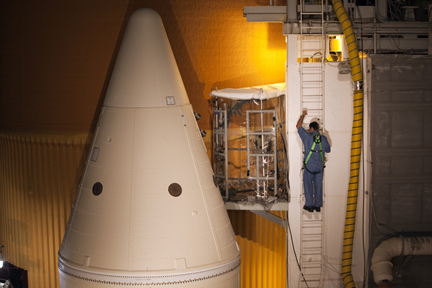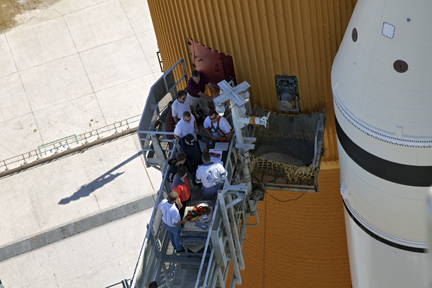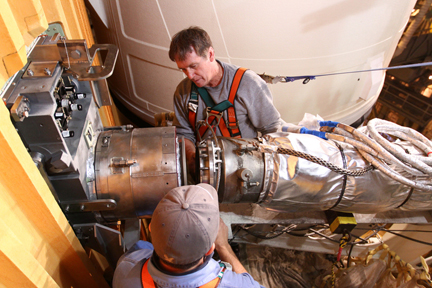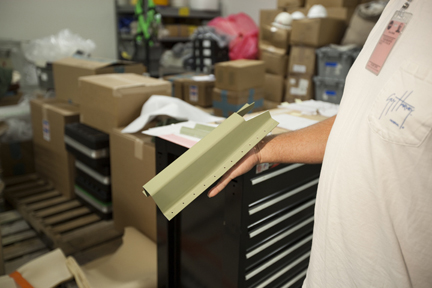Tank repairs in work while shuttle engineers assess 'fight rationale'
By WILLIAM HARWOOD
CBS News
KENNEDY SPACE CENTER, FL--Engineers are pressing ahead with work to repair small cracks in the shuttle Discovery's external tank and to finish installation and tests of a replacement hydrogen vent line quick-disconnect fitting that grounded the ship Nov. 5. At the same time, troubleshooters are assessing the structural integrity of the tank and its foam insulation to develop the necessary flight rationale, or justification, for proceeding with another launch as early as Nov. 30.
Bill Gerstenmaier, associate administrator for space operations at NASA headquarters, and John Shannon, the shuttle program manager at the Johnson Space Center in Houston, plan to brief reporters Monday after assessing the status of repairs and an engineering analysis of the tank's ability to withstand the normal loads, or forces, experienced during fueling, launch and the climb to space.
One concern is the potential for foam insulation to break away from the repaired area of the cracks, or similar areas, that could hit the shuttle's heat shield during the early stages of ascent when impact damage can be most severe. Other issues include proving that any fresh cracks that might form when the tank is loaded with supercold propellants are seen before launch and if they are not, that they will not grow or compromise the structural integrity of the tank during ascent.
Given the time available, developing flight rationale could be a challenge. The next shuttle launch window opens Nov. 30 and closes Dec. 6. NASA managers are examining other options that might be available later in the month. But if those don't pan out, and if Discovery misses the upcoming window, the fight would be delayed to late February, when the next shuttle launch window opens.
Despite the appearance, at least, of schedule pressure and the recurring problem of tank cracks -- some 38 stringer cracks have been seen in 20 tanks since switching to a lightweight aluminum-lithium alloy -- Shannon has told the shuttle team that NASA will not be driven by the schedule and that Discovery will not be cleared for launch without a solid flight rationale.
In any case, engineers at launch pad 39A have replaced the 7-inch gaseous hydrogen vent line quick-disconnect fitting and mounting plate on the side of Discovery's tank that leaked during fueling Nov. 5, scrubbing the ship's fourth launch attempt.
During the final hours of a shuttle countdown, a small amount of liquid hydrogen rocket fuel turns into a gas inside the ship's external tank. To maintain the proper pressure in the tank, a valve is periodically cycled to vent the gas overboard to a nearby "flare stack" where it is burned. During Discovery's fueling, sensors detected a major gaseous hydrogen leak at the vent line attachment fitting and launch was called off.
The quick-disconnect fitting and the ground umbilical carrier plate, or GUCP, that helps attach it to the side of the tank were removed and subjected to a detailed inspection. Engineers quickly discovered that the quick-disconnect hardware was not as precisely centered as required, a lack of concentricity that is believed to have allowed a leak path to develop when the hardware was exposed to ultra-low temperatures.
Replacement hardware has been installed that is as concentric as possible with the available components. Engineers are hopeful leak tests at higher-than-normal pressures will confirm a tight seal. NASA managers have not yet decided whether to order an actual fueling test to confirm leak-free performance under cryogenic conditions. But the engineering community is confident, officials say, that the carefully aligned hardware will work properly.
Meanwhile, another team of engineers and technicians is repairing the cracks that were discovered after the Nov. 5 launch attempt was called off. After removing damaged foam insulation, cracks were found in two adjacent structural braces, or stringers, making up the ribbed intertank section between the external tank's hydrogen and oxygen sections. The damage was seen just below the top flange of the intertank where it joins with the tank's liquid oxygen section.
The repair plan called for engineers to cut out the damaged stringer sections. Replacement sections will be riveted into place by this weekend, along with so-called doublers to provide additional strength. Fresh foam insulation then will be sprayed on and shaped to blend in with surrounding insulation. That work should be complete by Monday, followed by a four-day "cure."
Engineers also are evaluating techniques that can be used to look for signs of additional cracks under the foam insulation around the perimeter of the upper intertank flange on the side of the tank facing the shuttle. No foam loss from the flange area has ever been recorded, providing at least some additional confidence that cracks in this area are not a frequent or widespread phenomenon.
To make the opening of the shuttle's next launch window Nov. 30, Discovery's countdown must begin on Nov. 27. But it's not yet clear whether a fueling test will be required to test the vent line hardware, to make sure thermal stresses don't trigger more foam problems or both.
A tanking test and subsequent foam inspection would add additional confidence in the failure analysis and repair work, officials say, but no final decisions have been made. As for the timing of such a test, it could be added to the countdown or carried out as a stand-alone operation. How that might play into the shuttle's eventual launch date remains to be seen.
CBS News
 |
| A makeshift environmental control tent on the side of the shuttle Discovery's external tank where engineers will attempt to repair cracked ribs, or stringers. After replacement sections are spliced in, fresh foam insulation will be sprayed on. (Photo: NASA) |
 |
| Engineers install replacement gaseous hydrogen quick-disconnect hardware on the side of Discovery's external tank. (Photo: NASA) |
One concern is the potential for foam insulation to break away from the repaired area of the cracks, or similar areas, that could hit the shuttle's heat shield during the early stages of ascent when impact damage can be most severe. Other issues include proving that any fresh cracks that might form when the tank is loaded with supercold propellants are seen before launch and if they are not, that they will not grow or compromise the structural integrity of the tank during ascent.
 |
| A closeup showing the re-attachment of the hydrogen vent line to a replacement quick-disconnect fitting. (Photo: NASA) |
Despite the appearance, at least, of schedule pressure and the recurring problem of tank cracks -- some 38 stringer cracks have been seen in 20 tanks since switching to a lightweight aluminum-lithium alloy -- Shannon has told the shuttle team that NASA will not be driven by the schedule and that Discovery will not be cleared for launch without a solid flight rationale.
 |
| A replacement section of an external tank stringer is ready for installation on Discovery's tank. (Photo: NASA) |
During the final hours of a shuttle countdown, a small amount of liquid hydrogen rocket fuel turns into a gas inside the ship's external tank. To maintain the proper pressure in the tank, a valve is periodically cycled to vent the gas overboard to a nearby "flare stack" where it is burned. During Discovery's fueling, sensors detected a major gaseous hydrogen leak at the vent line attachment fitting and launch was called off.
The quick-disconnect fitting and the ground umbilical carrier plate, or GUCP, that helps attach it to the side of the tank were removed and subjected to a detailed inspection. Engineers quickly discovered that the quick-disconnect hardware was not as precisely centered as required, a lack of concentricity that is believed to have allowed a leak path to develop when the hardware was exposed to ultra-low temperatures.
Replacement hardware has been installed that is as concentric as possible with the available components. Engineers are hopeful leak tests at higher-than-normal pressures will confirm a tight seal. NASA managers have not yet decided whether to order an actual fueling test to confirm leak-free performance under cryogenic conditions. But the engineering community is confident, officials say, that the carefully aligned hardware will work properly.
Meanwhile, another team of engineers and technicians is repairing the cracks that were discovered after the Nov. 5 launch attempt was called off. After removing damaged foam insulation, cracks were found in two adjacent structural braces, or stringers, making up the ribbed intertank section between the external tank's hydrogen and oxygen sections. The damage was seen just below the top flange of the intertank where it joins with the tank's liquid oxygen section.
The repair plan called for engineers to cut out the damaged stringer sections. Replacement sections will be riveted into place by this weekend, along with so-called doublers to provide additional strength. Fresh foam insulation then will be sprayed on and shaped to blend in with surrounding insulation. That work should be complete by Monday, followed by a four-day "cure."
Engineers also are evaluating techniques that can be used to look for signs of additional cracks under the foam insulation around the perimeter of the upper intertank flange on the side of the tank facing the shuttle. No foam loss from the flange area has ever been recorded, providing at least some additional confidence that cracks in this area are not a frequent or widespread phenomenon.
To make the opening of the shuttle's next launch window Nov. 30, Discovery's countdown must begin on Nov. 27. But it's not yet clear whether a fueling test will be required to test the vent line hardware, to make sure thermal stresses don't trigger more foam problems or both.
A tanking test and subsequent foam inspection would add additional confidence in the failure analysis and repair work, officials say, but no final decisions have been made. As for the timing of such a test, it could be added to the countdown or carried out as a stand-alone operation. How that might play into the shuttle's eventual launch date remains to be seen.